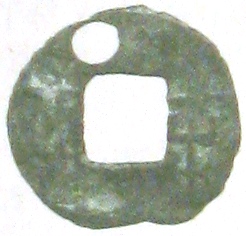The ban liang coin was the official money of the state of Qin during the Warring States period. When Qin Shi Huang conquered the various “warring states” and unified China for the first time in 221 BC, the ban liang became the official coinage of the empire. The ban liang continued as the official currency even into the beginning of the Han Dynasty.
An article in a Chinese numismatic publication introduces a newly discovered and never seen before variety of the Chinese ban liang coin. In addition to the normal square hole in the center of the coin, these coins have an additional one or two holes drilled into them.

The Volume One 2010 edition of “China Numismatics” has an article entitled “Zhangjiachuan Prefecture Excavates ‘Drilled Hole’ Ban Liang“.
The author explains that in the summer of 2006 he bought about 200 recently unearthed ban liang coins. The coins were excavated in Zhangjiachuan prefecture of Gansu Province in northwest China.
Among the coins purchased were a few of a variety that had neither been seen before or reported in the literature.
As can be seen in the illustration*, these coins have one or two additional holes.
The author states that these coins were cast in the state of Qin during the middle to late Warring States Period (475 BC – 221 BC). The coins range in diameter of 23-33 mm and in weight of 1-8 grams.
The coin shown here has the largest drilled hole but is actually the smallest and lightest of the coins with a diameter of 23 mm and a weight of only 1 gram.
The additional holes are in various areas above or below the square hole. Some have one large hole while others have two smaller holes.
The author carefully examined each coin and determined that the holes, while not perfectly round, were definitely intentionally made by hand after the casting of the coin. The holes are not the result of poor casting technique. The holes were apparently drilled in the larger and thicker areas of each coin and placed so as to avoid damaging the Chinese character inscription.
Unfortunately, the specifics as to where the coins were dug up is unknown so we do not know if the coins were buried in a pit or came from a tomb. Knowing whether the coins came from a buried cache or from a grave could help provide an explanation as to the reason for the holes.
The author speculates that the holes were not made so that the coins could be worn as an ornament or pendant because the off-center placement of the holes would not allow the coin to hang correctly.
Since coins were a symbol of wealth, it is possible that they may have been burial objects.
The author concludes that no matter what the ultimate purpose, the holes were intentionally handmade and not the result of inferior casting technique.
As I discuss in detail at “Emergence of Chinese Charms“, ban liang coins began to appear with various marks and symbols at the beginning of the Western Han Dynasty (206 BC – 24 AD). These symbols include “stars” (dots), “moons” (crescents), “suns” (circles), etc., and symbols on coins gradually became more and more complex until they finally developed into true charms and amulets.
While the purpose of the additional holes on the newly discovered ban liang coins remain unknown, they may very well have been the precursor to the “stars” ,”moons” and “suns” that appeared on the later Han Dynasty coins.
* Color added to black & white image to enhance features
Hello Gary. I’m an avid coin collector and I’m very interested in ancient Chinese coins.
First at all, let me tell you how impressed I am about your web site and the knowledge you have for Chinese coins and history. I truly learned a lot from you.
It’s a very interesting article that make me wonder if there are more different varieties of Ban Liang coins out there. I personally have a Ban Liang coin that I couldn’t find any identical one from internet. It has normal script of Ban Liang from right to left, but when you turn it 90 degree clockwise, there’s another script of Ban Liang from right to left. If you would like, I could send you a picture later on.
Best regards,
Manning Luo
Hi Manning,
From your description, I think your ban liang is similar to this one.